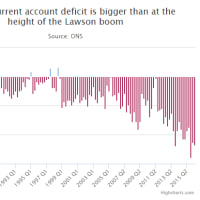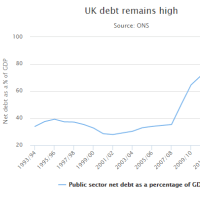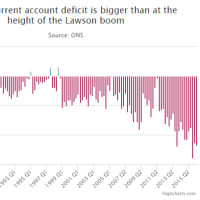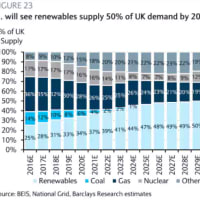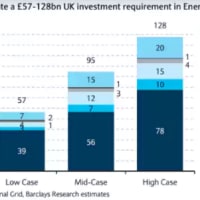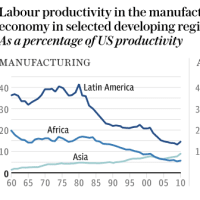そうこなくっちゃ。
トムさんの記事は久々ですが、景気の良い話でGJですね、さいこーですね。
テレグラフはこうでないとねー、さもなければ他の新聞社みたいに貧乏神が来ちゃうよ。
がんばれー。
After a decade of decline, it's time for the dollar to have its day
(10年落ち込んでたけど、今こそ米ドルの時代!)
By Tom Stevenson
Telegraph: 2:51PM BST 11 May 2013


トムさんの記事は久々ですが、景気の良い話でGJですね、さいこーですね。
テレグラフはこうでないとねー、さもなければ他の新聞社みたいに貧乏神が来ちゃうよ。
がんばれー。
After a decade of decline, it's time for the dollar to have its day
(10年落ち込んでたけど、今こそ米ドルの時代!)
By Tom Stevenson
Telegraph: 2:51PM BST 11 May 2013
Equity investors' eyes are fixed on the currency markets this week as, for the first time in four years, it has taken more than 100 yen to buy a US dollar.
株式投資家の目は今週、為替相場にくぎ付けになりました。4年ぶりに、1ドルを買うのに100円以上かかるようになったのです。
Everyone knows that a weak yen is good for Japan's big exporters like Toyota. Plot a chart of the exchange rate and the car-maker's share price and the lines are barely distinguishable, so great is the correlation between the two.
皆知ってますよ。
円安はトヨタみたいな日本の大手輸出業者にとって良いことだって。
為替レートのチャートと自動車メーカーの株価チャートとか、殆ど見分けが付かないくらいでしょ。
What's more interesting to me is whether the flip side of this trade, dollar strength, is more than a short-term blip. The dollar has been falling against a basket of other currencies for 10 years now. If that process has run its course and the dollar is stabilising or even set to appreciate again, that could have big implications for investors' asset allocation decisions.
僕がもっと興味をひかれたのは、この裏側での米ドルの値上がりが短期的なもの以上なのかどうか、ってことです。
米ドルはかれこれ10年間、様々な通貨に対して値下がりしてきました。
それの軌道を外れて、米ドルが安定化中、または再上昇しかけているのなら、これは投資家の資産配分決定に大きな影響をもたらすでしょう。
The last 10 years was a period in which the US government spent heavily on costly military adventures abroad and cut taxes at home. The resultant deterioration in America's fiscal position unsurprisingly weighed on the value of the dollar, helped commodity prices surge and drove investors into alternative homes for their savings, such as emerging markets.
この10年間は、米政府が金のかかる海外軍事アドベンチャーにがんがん金を使いながら、国内では減税を行うという期間でした。
その結果として起こった米国の財政状態の悪化は、驚くまでもなく、米ドルの価値を圧迫して、商品価格を急騰させ、投資家の資金を新興市場などに向かわせました。
Ten years earlier things looked very different. President Bill Clinton benefited from tax rises and a peace dividend after the fall of the Berlin Wall. The fiscal deficit, albeit briefly, became a surplus. Coupled with positive real interest rates, the dollar rallied during the 1990s, commodities slumped and equities, especially US stocks, were the best-performing asset class by far.
更にその10年前、様相は全く違っていました。
クリントン大統領は増税とベルリンの壁崩壊後の平和に恩恵を被りました。
財政赤字は、まあ短期出来ではありますが、黒字に転じました。
実質金利の上昇も追い風となって、1990年代ドルは値上がりして、商品価格は下落し、株式(特に米国株)はどの資産よりも圧倒的に素晴らしいパフォーマンスを見せました。
The current situation feels a lot more like the Nineties than the Noughties. One reason is the real progress being made on both the budget and trade deficits. Withdrawing from Iraq and Afghanistan and the strongest economic recovery in the developed world has cut the gap between tax receipts and expenditure from $1.5 trillion (£980bn) to less than $1 trillion. The deficit is heading back to just 3pc to 4pc of GDP.
現在の状況は、2000年代というよりも1990年代みたいな感じですね。
その理由の一つは、財政赤字と貿易赤字の両方で本格的な改善が出ているからです。
イラクとアフガニスタンからの撤収と、先進国での堅調な景気回復によって、歳入と歳出のギャップは1.5兆ドルから1兆ドルを切るまでに縮まりました。
財政赤字はGDPの僅か3-4%に戻りつつあります。
On trade, the usual link between economic recovery and a worsening trade position (as imports rise) has broken down. The reason is shale. Energy imports have fallen by a third thanks to the fracking revolution and if oil and gas exports get the green light the trade balance can only get better, adding more fuel to the dollar fire.
貿易はどうかというと、景気回復と貿易赤字というお馴染みの関連性は断たれました。
その理由は、シェールです。
フラッキング・レボリューションのおかげで、エネルギー輸入は3分の1も減りました。
それに、石油とガスの輸出にGOサインが出れば、貿易収支は良くなる一方で、米ドル・ファイヤーに更なる燃料投下となるでしょう。
A third driver of dollar appreciation will in time come from a reining in of the Fed's money printing as unemployment falls to Ben Bernanke's target of 6.5pc. If the Japanese and Europe are still easing, the dollar will come to seem like an ever safer haven.
3番目の米ドル上昇推進力は、失業率がバーナンキFRB議長の目標である6.5%まで下がれば、FRBも紙幣増刷を減らしていくので、いずれやって来ます。
日本とヨーロッパが緩和を継続すれば、米ドルはこれまで以上にセーフヘイヴンと見なされることでしょう。
So what does this mean for investors? First, it looks like the commodity super-cycle has finally hit the buffers. The usual lag between higher prices and new supply coming on stream was already bad news for commodities. A slowing in growth in China and a strengthening dollar will complete the bear case for resources.
というわけで、これは投資家にとってどういう意味でしょう?
その1。
商品スーパーサイクルは遂に終了のようです。
価格高騰の新規供給源続出のタイムラグは既に商品には悪いニュースです。
中国の成長鈍化と米ドルの上昇が、商品相場ベア論を完成させるでしょう。
Second, the relationship between the dollar and share valuations in the US is quite different from that in Japan. Less dependent on exports than Japan, the US actually benefits from a stronger currency. The price-earnings ratio of the US market rose in line with the dollar in the 1990s and fell as the dollar weakened in following decade. A stabilising dollar could therefore add impetus to the recent re-rating of the US market.
その2。
米ドルと米国株評価の関係は、日本とかなり違います。
日本よりも輸出依存度が低いので、米国は実際にはドル高の方が好都合なのです。
1990年代、米国株のPERは米ドルと一緒に上昇し、その次の10年間には、米ドルと一緒に下降線を辿りました。
従って、米ドル安定化は最近の米市場の再評価にとって推進力を増すわけです。
Third, a strengthening dollar could also have implications for the relative performance of US and emerging market stocks.
その3。
ドル高は米国と新興市場の相対的パフォーマンスに影響があります。
In one important way things are different today from 20 years ago. Emerging markets are less dependent on dollar-denominated loans, so a rising dollar will provide less of a headwind than it did in the 1990s. But at the margin, a strong dollar reduces the need for US investors to seek returns elsewhere and will most likely lead to American leadership of global stock markets in the next few years.
ここに一つ、20年前との大きな違いがあります。
新興市場のドル建て融資依存度は低くなりましたから、ドル高が1990年代ほどの向い風にならないのです。
とはいえ、ドル高のおかげで米国の投資家が国外で高金利を求める必要が減り、今後2-3年間、米国が世界の株式市場のリーダーシップをとる確率は非常に高くなります。
The other dog that hasn't barked yet is the wall of Japanese money which could seek higher returns abroad if the decline in the value of the yen continues to 110 yen to the dollar and beyond. If the famously savvy Mrs Watanabe, who holds the purse strings in Japanese households, senses a resurgence in the value of the dollar, then US assets could find another very powerful support.
未だ眠りこけたままのもう一匹のワンコは、ジャパン・マネーの壁です。
ジャパン・マネーは、円安が1ドル110円、そしてそれ以上に進めば高金利を求めて海外進出すると思われます。
日本の家計の財布を握っている、かの有名な抜け目のないミセス・ワタナベは、米ドルの再上昇を察知して、米国資産はまた非常に強力なサポートを見出すかもしれません。
Tom Stevenson is an investment director at Fidelity Worldwide Investment. The views expressed are his own. He tweets at @tomstevenson63











